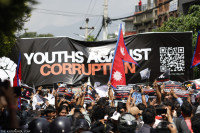Opinion
Lumbini at risk
Factories continue to be built at Buddha’s birthplace posing an environmental threat
Ram Charitra Sah
Lumbini, the birthplace of Lord Buddha, a pilgrimage site for all the people of the world, the fountain of peace and a Unesco World Heritage Site, is facing a serious environmental threat due to the proliferation of factories all around it. This requires the immediate attention of the government of Nepal, concerned ministries and Lumbini Development Trust.
In addition to the cement factory which was established despite the Industrial Promotion Board’s 2009 decision not to allow any carbon emitting factories within a 15-km radius of the sacred site, there are 57 manufacturing plants producing bricks, cement, clinker, steel, noodles, paper and flour registered in the Lumbini Protected Zone. Among them, 11 cement factories, two steel factories, one paper mill and one noodles factory have been identified as being the largest polluters. Increased solid waste from tourism and noise and air pollution due to the use of generators by hotels, restaurants and even monasteries also need to be addressed.
A study conducted by the World Health Organisation (WHO) showed that the air at the Lumbini World Heritage Site contained particulate matter amounting to 270 micrograms per cubic metre (µg/m3) which is 11 times higher than WHO’s permissible limit. This level of air pollution is extremely dangerous to the health of living beings and exemplifies the urgency of the problem. Noise pollution and emission by heavy duty generators are also on the rise. The noise pollution level has been found to exceed the Nepal government’s standard of 50 decibels at daytime and 40 decibels at night-time. Solid waste is also increasing at Lumbini. According to Asian Development Bank estimates, garbage generation will reach 617 tonnes by 2020 and 1,307 tonnes by 2030 as there is no scheme to manage it.
Appeals to the government to do something about the pollution at the Buddha’s birthplace by the Centre for Public Health Environmental Development (CEPHED) led to a number of decisions to address pollution issues in 2013, but they were never implemented. The government of Nepal through its line ministries such as the Ministry of Population and Environment, Ministry of Industry and the Ministry of Culture, Tourism and Civil Aviation has initiated several legislative and institutional frameworks specifically dedicated to environmental conservation, preservation and protection of the World Heritage Site. The Lumbini Development Trust formed by Lumbini Development Trust Act 1985 for the purpose of restoring Lumbini Garden under the master plan is the key institutional strength addressing the pollution and development related issues.
Nepal is party to the Convention Concerning the Protection of the World Cultural and Natural Heritage 1972 whose objectives are identification, protection, conservation, presentation and transmission to future generations of the cultural and natural heritage beyond national territories. This convention was accepted by Nepal in 1978. Additionally, the Ministry of Population and Environment has enacted numerous environmental quality standards for air, water, noise, emissions and industrial effluents which need to be effectively implemented and complied with. Most importantly, the Industrial Promotion Board of the Ministry of Industry decided in 2009 that no carbon emitting industries would be allowed to be established within a 15-km radius of the Lumbini Protected Zone. However, at least three to four carbon emitting and highly polluting cement factories have been set up since this decision was made.
Even though numerous such legislative and institutional frameworks and policies, plans, decisions and standards are in place, environmental pollution in Lumbini is continuing and increasing, putting public health, flora, fauna, the environment and culturally important temples, stupas and monasteries including the Mayadevi Temple and the 2,000-year-old Ashoka Pillar under severe threat of degradation. The construction of a new cement factory named Sri Ram Cement Industry is currently moving ahead at Bhaishakhadar, Harnaiya VDC despite having been halted several times. The construction work at the proposed factory must be stopped immediately to prevent new sources of environmental pollution from coming up.
Finally, a pledge by the national government and officials as well as individuals and organisations to protect and preserve the World Heritage Site of Lumbini through effective implementation of all the legislative and institutional frameworks dedicated to its protection would be a real contribution during the upcoming international Buddhist conference and celebration of the 2,560th Buddha Jayanti in Nepal.
Sah is the executive director of the Centre for Public Health and Environmental Development (CEPHED)




 10.12°C Kathmandu
10.12°C Kathmandu










